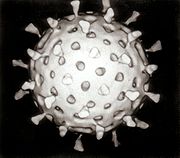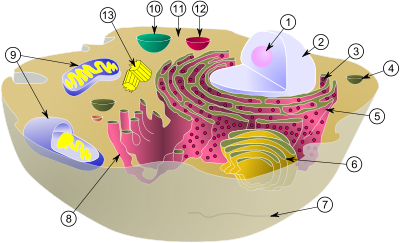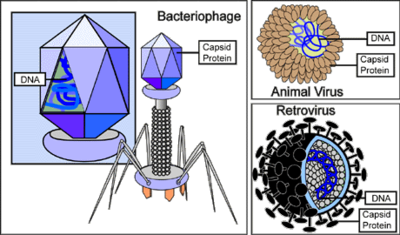
Introduction to viruses
Did you know...
SOS Children have produced a selection of wikipedia articles for schools since 2005. A quick link for child sponsorship is http://www.sponsor-a-child.org.uk/
| Virus | |
|---|---|
 |
|
| Computer reconstruction of a rotavirus particle | |
| Scientific classification | |
| Groups | |
|
I: dsDNA viruses |
Viruses are parasites that reproduce inside the cells of the organisms they infect. When a virus infects a cell, it reprograms that cell's normal biochemical processes thereby forcing the cell to make thousands of identical copies of the infecting virus by using the cell's protein, DNA and RNA building blocks. This process usually kills the infected cell.
Viruses are grouped depending on the type of organism they infect. Therefore viruses are either animal, plant or bacterial types. They are so small that it would take 30,000 to 750,000 of them, side by side, to cover 1 centimetre. The origins of viruses is unclear; some may have evolved from plasmids or transposons, which are stretches of DNA that can exist separately from chromosomes. Other viruses may have evolved from bacteria.
A virus consists of two parts: the genetic material, a nucleic acid that contains all the information necessary for the production of new virus particles, and a protein coat that protects this genetic material. The coat is called a capsid and can either be a simple container, or a much more complex structure, containing enzymes. Capsid shapes vary from simple helical and icosahedral (polyhedral or near-spherical) forms, to more complex structures with tails or an envelope.
Plant, animal and bacterial cells all contain two types of nucleic acid. The genetic information needed to make new proteins is always encoded in DNA: this code is translated into a specific type of RNA called messenger RNA that carries the information to the parts of the cell that make proteins. In contrast, each type of virus only contains one type of nucleic acid, either DNA or RNA.
Within cells there are structures called organelles, each organelle has one or more important functions. These organelles along with cell enzymes are needed for metabolism and life. Viruses do not have organelles and must use those within a cell to reproduce. Outside of a host cell, viruses are completely inactive and are considered neither living nor dead. Indeed, it is controversial whether viruses are actually living organisms. Some consider them non-living since they do not meet all the criteria of the definition of life. However, viruses do have genes and evolve over time.
Viral infections in human and animals usually cause an immune response and disease. Often, a virus is completely eliminated by the immune system. Antibiotics have no effect on viruses, but antiviral drugs have been developed to treat life-threatening infections. Vaccines that produce lifelong immunity can prevent virus infections.
Viruses spread in many different ways. Viruses of plants are often spread from plant to plant by insects acting as vectors. Specific virus infections of animals and humans are also spread by biting insects. But not all viruses can be spread in this way. Each species of virus relies on a specific method. Some, such as influenza are carried by the air and are spread by coughing and sneezing. Others, such as norovirus and rotavirus contaminate food or water. HIV is one of several viruses that are transmitted during sex.
Origins of viruses
The origin of modern viruses is not entirely clear but molecular techniques have been the most useful means of hypothesising how they arose, and two main hypotheses currently exist.
Small viruses with only a few genes may be runaway stretches of nucleic acid originating from the genome of a living organism. Their genetic material could have been derived from transferable genetic elements such as plasmids or transposons, that are prone to moving within, leaving, and entering genomes. In this way new viruses are constantly emerging and therefore, not all viruses have viral "ancestors".
Viruses with larger genomes, such as poxviruses, may have once been small cells that parasitised larger host cells. Over time, genes not required by their parasitic lifestyle would have been lost in a streamlining process known as retrograde-evolution or reverse-evolution. The bacteria Rickettsia and Chlamydia are living cells that, like viruses, can only reproduce inside host cells. They lend credence to the streamlining hypothesis, as their parasitic lifestyle is likely to have caused the loss of genes that enabled them to survive outside a host cell.
Discovery of viruses
In the late 19th century Charles Chamberland made a filter with holes small enough to remove bacteria. Dimitri Ivanovski used this filter to study tobacco mosaic virus. He published the results of his experiments which proved that crushed leaf extracts of infected tobacco plants were still infectious after filtration. At the same time, several other scientists proved that, although these agents were different from bacteria, they could cause disease, and that viruses were about a hundred times smaller than bacteria. The term virus was first used by the Dutch microbiologist Martinus Beijerinck who used the words "contagium vivum fluidum" to mean “soluble living germ”. In the early 20th century, Frederick Twort discovered viruses that infect bacteria. Felix d'Herelle described viruses that caused areas of death on thin cell cultures on agar. Counting these dead areas allowed him to count the viruses in the suspension.
With the invention of electron microscopy came the first images of viruses. In 1935 Wendell Stanley examined tobacco mosaic virus and found it to be mostly made from protein. A short time later the virus was separated into protein and nucleic acid parts. A problem for early scientists was their inability to grow viruses without using live animals. The breakthrough came in 1931, when Ernest William Goodpasture grew influenza and several other viruses in fertile chicken eggs. However, some viruses would not grow in chicken eggs. The problem was solved in 1949 when John Franklin Enders, Thomas H. Weller and Frederick Chapman Robbins grew polio virus in cultures of living animal cells.
Structure of viruses
A virus particle, known as a virion consists of nucleic acid surrounded by a protective coat of protein called a capsid. Viral proteins form the capsid and these proteins form recognisable units called capsomers. The arrangement of the capsomers can either be icosahedral (20–sided) or helical. Most viruses made from DNA are icosahedral and RNA viruses are either helical or icosahedral.The proteins that attach to the nucleic acid are known as nucleoproteins, and together form a nucleocapsid. Some viruses are surrounded by a bubble of lipid called an envelope. Most DNA viruses do not have an envelope but most RNA viruses are enveloped.
Size
Viruses are some of the smallest infectious agents and the majority of them can only be seen by electron microscopy. Most viruses are around 100 nm in diameter but their sizes range from 20 to 300nm. They are so small that it would take 30,000 to 750,000 of them, side by side, to cover 1 centimetre.
Virus genes
There are two kinds of genetic material: deoxyribonucleic acid (DNA) and ribonucleic acid (RNA). The biological information contained in an organism is encoded in its DNA or RNA sequence. Most organisms use DNA, but many viruses (e.g., retroviruses) have RNA as their genetic material. The DNA and RNA of viruses consists of either a single strand or a double helix.
Viruses, although simple compared to cell-based organisms, are very efficient at reproducing. They have only a few genes compared to humans who have 20,000–25,000. For example, Influenza virus has only 8 genes and rotavirus has 11. These genes encode structural proteins that form the virus particle, or non-structural proteins, that are only found in cells infected by the virus.
Most viruses produce a protein that is an enzyme called a polymerase. Polymerase is used to make new copies of the viral DNA or RNA. Often this protein is also a structural protein that forms part of the virus particle. These polymerase enzymes are often much more efficient than their counterparts produced by the host cell.
In some species of virus the DNA or RNA is not a continuous molecule but is split into several separate strands. These are called segmented genomes. The Influenza virus genome is made up from 8 separate segments of RNA. When two different strains of influenza virus infect the same cell, these segments can mix and produce new strains of the virus, this is called reassortment.
Virus protein synthesis

Cells make new protein molecules from amino acid building blocks based on information encoded in RNA. Protein synthesis generally consists of two major steps: transcription and translation.
Transcription is the process where genetic information in DNA is used to produce messenger RNA which migrates through the cell. The mRNA molecules bind to protein-RNA complexes called ribosomes where they are used to make proteins. This is called translation. The protein amino acid sequence is based on the mRNA base sequence.
Virus particles are made from several proteins that they cannot produce by themselves, therefore they rely on the host cell to make them. Viruses do this in many different ways, however, eventually all of them produce mRNA. In some RNA viruses the viral genome RNA functions directly as mRNA without further modification. For this reason, these viruses are called positive-sense RNA viruses.
In other RNA viruses, the genomic RNA is a complementary copy of mRNA and these viruses rely on the cell's or their own enzyme to make mRNA. These are called negative-sense RNA viruses. In viruses made of DNA the method of mRNA production is similar to a cell. Retroviruses are very different, they are based on RNA, but inside the host cell a DNA copy of their RNA is made. This DNA is then incorporated into the host's and copied into mRNA by the cell's normal pathways.
Virus life-cycle
Viruses can only multiply within a living cell. When a virus infects a cell, it makes the cell form new viruses by synthesising new viral nucleic acid and proteins, thereby forming complete new virus particles.
There are six basic, overlapping stages in the life cycle of viruses in living cells:
Attachment is a binding of the virus to specific molecules on the surface of the cell. This specificity restricts the virus to a very limited type of cell. For example, the human immunodeficiency virus (HIV) infects only human T cells, because its surface protein, gp120, can only react with CD4 and other molecules on the T cell's surface. This mechanism has evolved to favour those viruses that only infect cells that they are capable of replicating in.
Penetration: following attachment, viruses enter the host cell by endocytosis or by fusion with the cell.
Uncoating happens inside the cell when the viral capsid is removed and destroyed by viral enzymes or host enzymes, thereby exposing the viral nucleic acid.
Replication of virus particles is the stage where a cell uses foreign messenger RNA in its protein synthesis systems to produce viral proteins. The RNA or DNA synthesis abilities of the cell produce the virus' nucleic acids by viral polymerase.
Assembly takes place in the cell when the newly created viral proteins and nucleic acid combine to form new virus particles.
Release occurs when the new viruses escape from the cell. Most viruses achieve this by causing the cells to burst, a process called lysis. Other viruses such as HIV are released more gently by a process called budding.
Viruses and disease
Human diseases caused by viruses include the common cold, the flu, chickenpox and cold sores. Serious diseases such as Ebola, AIDS and influenza are caused by viruses. The ability of viruses to cause disease is called virulence and the mechanism is called pathogenesis. Viruses cause different diseases depending on the types of cell that they infect. Some viruses can cause life-long or chronic infections where the viruses continue to replicate in the body despite the hosts' defense mechanisms. This is common in Hepatitis B virus and Hepatitis C Virus infections. People chronically infected with Hepatitis B virus are known as carriers who serve as reservoirs of infectious virus. In some populations, if there is a high proportion of carriers, a disease is said to be endemic.
There are many ways in which viruses spread from host to host but each species of virus uses only one or two. Many viruses that infect plants are carried by insects called vectors. Common vectors include Bacteria, Fungi, Nematodes, arthropods and arachnids. Some viruses that infect animals and humans are also spread by biting insects, but direct animal-to-animal, person-to-person or animal-to-person transmission is more common. Some virus infections are spread by contaminated food and water, ( Norovirus and Rotavirus), others are airborne, (Influenza virus). Viruses such as HIV, Hepatitis B and Hepatitis C are often transmitted by unprotected sex or contaminated hypodermic needles. It is important to know how each different kind of virus is spread in order to prevent infections and epidemics.
Prevention and treatment
Vaccines
Vaccination is a way of preventing infections by viruses. Vaccines were used to prevent viral infections long before the discovery of the actual viruses. Their use has resulted in a dramatic decline in morbidity (illness) and mortality (death) associated with viral infections such as polio, measles, mumps and rubella. Smallpox infections have been eradicated. Currently vaccines are available to prevent over thirteen viral infections of humans and more are used to prevent viral infections of animals. Vaccines may consist of live or killed viruses. Live vaccines contain weakened forms of the virus that are no longer virulent. These are referred to as attenuated vaccines. Live vaccines can be dangerous when given to immunocompromised people i.e. people with weak immunity, because in these people, the weakened virus can cause the original disease. Biotechnology and genetic engineering techniques are used to produce subunit vaccines. These vaccines use only the capsid proteins of the virus. Hepatitis B vaccine is an example of this type of vaccine. Subunit vaccines are safe for immunocompromised patients because they cannot cause the disease.
Antiviral drugs
Over the past twenty years the development of antiviral drugs has increased rapidly. This has been driven by the AIDS epidemic. Antiviral drugs are often nucleoside analogues, (fake DNA building blocks), which are incorporated into the viral DNA during its replication. DNA, and thus virus, replication is then halted because these analogues lack the hydroxyl groups which along with phosphorus atoms, link together to form the strong "backbone" of the DNA molecule. This is called DNA chain termination. Examples of nucleoside analogues are aciclovir for Herpes virus infections and lamivudine for HIV and Hepatitis B virus infections. Aciclovir, is one of the oldest and most frequently prescribed antiviral drugs. Other antiviral drugs target different stages of the viral life cycle. HIV is dependent on a proteolytic enzyme called the HIV-1 protease for it to become fully infectious. There is a class of drugs called protease inhibitors which have been designed to inactivate the enzyme.
Hepatitis C is caused by an RNA virus. In 80% of people infected, the disease is chronic and without treatment they remain infectious for the rest of their lives. However, there is now an effective treatment using the nucleoside analogue drug ribavirin combined with interferon The treatment of chronic carriers of the Hepatitis B virus by using a similar strategy using lamivudine is being developed.






